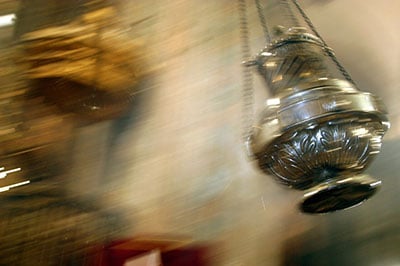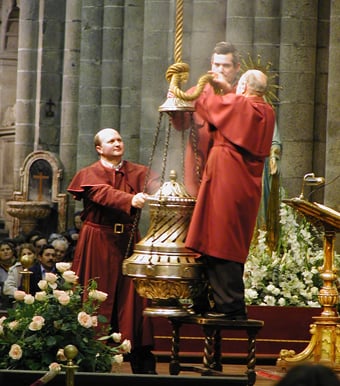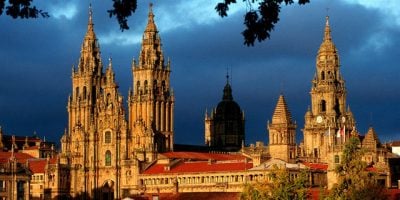What is The Botafumeiro And When Can I See it?
The ‘Botafumeiro’ is the famous giant thurible or censer in the Santiago de Compostela cathedral. It has been used since the Middle Ages, originally to clean the air when crowds of pilgrims, having completed the Camino de Santiago, arrived in Santiago de Compostela after their long journey.
The Codex Calixtinus, the first Camino de Santiago ‘guide-book’, refers to the ‘Botafumeiro’ as Turibulum Magnum, which means this ritual has been taking place at least since the 12th century.
The current ‘Botafumeiro’ dates back to 1851, and it’s made of silver-plated brass, weighing 53kgs when empty and up to 10 kgs more when full. Eight men, called ‘Tiraboleiros’, are required to operate the ‘Botafumeiro’.
After being filled with incense and coal by the ‘Tiraboleiros’, the 1,5mtr-high ‘Botafumeiro’ is tied to a rope hanging by the altar and set in motion with great precision, forming an impressive 65-meter-long arched trajectory along the cathedral.
In only a minute and a half, the ‘Botafumeiro’ reaches 68km per hour. The ‘Botafumeiro’ is generally used on special dates for important liturgical celebrations such as Christmas Day and Saint James Day.
Botafumeiro Calendar:
- 6th January: Epiphany
- Easter Sunday
- Ascension of Our Lord (May)
- 23rd May: Apparition of the Apostle
- Pentecost Sunday (50 days after Easter)
- 25th July: Feast of Saint James
- 15th August: Assumption of the Blessed Virgin
- 1st November: All Saints’ Day
- Feast of Christ the King (Sunday before the first Sunday of Advent in November)
- 8th December: Immaculate Conception
- 25th December: Christmas Day
- 30th December: Arrival of the Holy Apostle
Visit the Cathedral of Santiago’s official website for updates and changes. Individuals can also request and book the Botafumeiro (you must check with the cathedral for fees).
Requests should be addressed to the Pilgrims Office: Oficina de Acogida de Peregrinos, Rúa Carretas, 33, CP 15705, Santiago de Compostela Tel: +34 981 568 846. [email protected] – peregrinossantiago.es.

Description of the Botafumeiro
The Botafumeiro is suspended from a pulley mechanism in the dome on the church’s roof. The current pulley mechanism was installed in 1604. The present Botafumeiro is made of an alloy of brass and bronze and is plated with a very thin 20-micrometre layer of silver.
The current Botafumeiro, which has a golden sheen, was created by the gold and silversmith José Losada in 1851. The Santiago de Compostela Botafumeiro is the largest ‘Censers’ in the world, weighing 80 kg and measuring 1.60 m in height. It is normally on exhibition in the cathedral’s library. Still, during certain important religious occasions, it is brought to the cathedral floor and attached to ropes hung from the pulley mechanism.
Another large Thurible is used in the other masses in the cathedral, called “La Alcachofa” (literally, “The Artichoke”) or “La Repollo” (literally, “The Cabbage”). La Alcachofa is a silver-coloured metal censer. It was created in 1971 by sacred artisans working under the craftsman Luis Molina Acedo.
The ropes typically last about 20 years before they have to be replaced. However, a thicker rope was recently used than usual, and the extra rubbing produced premature wear. Therefore, this thicker rope had to be replaced sooner than expected in 2004. Before 2004, the ropes were woven from hemp, or a type of grass called esparto, and made in Vigo, Spain. Since 2004, a rope made of synthetic material has been used.
Shovels fill the Botafumeiro, or the Alcachofa, with about 40 kg of charcoal and incense. The thurible is tied to the rope with elaborate knots. The censer is pushed initially to start its motion. Eight red-robed Tiraboleiros pull the ropes, producing increasingly large oscillations of the censer. The thurible’s swings almost reach the ceiling of the transept. The incensory can reach speeds of 68 km/h as it dispenses thick clouds of incense.
At the top of the swing, the Botafumeiro reaches a height of 21 meters. It swings in a 65-meter arc between the Azabachería and Praterias doorways at the ends of the transept. The maximum angle achieved is about 82°. The maximum can be reached after about 17 cycles and requires about 80 seconds of swinging. It costs about 250€ for each thurible “performance” at the cathedral. Although expensive, swinging the thurible is popular with pilgrims, tourists, and visitors. The Botafumeiro produces large volumes of smoke.
This follows the well-known religious saying, “More incense, less nonsense.” The swinging Botafumeiro dispenses clouds of incense. Tiraboleiros The Botafumeiro is carried and swung by eight men in red robes, called Tiraboleiros. The term “Tiraboleiro” is a Galician distortion of the Latin word “Turifer”, which means “incense carrier”, and from which is derived the English equivalent, “thurifer”. This comes from the Latin words “thus”, meaning incense, and “fero”, meaning “carry”. There is a comparable term in Spanish, a “Turiferario”. The current chief “tiraboleiro” is Armando Raposo.
History of the Botafumeiro
One tradition is that the use of a swinging censer in the Santiago de Compostela Cathedral began in the 11th century. Arriving pilgrims were tired and unwashed. Incense smoke was also believed to have a prophylactic effect during plagues and epidemics. Of course, incense burning is also an important part of the liturgy, an “oration to God” or a form of prayer.
In the 13th century, the pulley mechanism was changed to incorporate a set of coaxial drums of different diameters.[15] Without this innovation, the most significant excursion of the Botafumeiro would be about 1.5 meters, the length of the rope pulled by the Tiraboleiros. In the 15th century, France’s King Louis XI (1423–1483) donated money to the cathedral to replace their medieval thurible, which was made of silver. A new silver thurible was put into service in 1554. Unfortunately, Napoleon’s troops stole this ornate vessel in April 1809, during an episode in the Spanish War of Independence (1808–1814).[7] Therefore, the Louis XI censer was replaced by the present less ostentatious Losada thurible in 1851.
After 155 years of use, the Botafumeiro was restored in early 2006 by artisans and craftsmen working under Luis Molina Acedo. They repaired the dents and cracks in the Botafumeiro and then reapplied a 20-micrometre thick plating of silver to the vessel. Many other cathedrals had similar large thuribles at one time—however, most of the other cathedrals discontinued using their swinging censers over the years.
Several accidents have occurred during the swinging of the Botafumeiro over the years. Apparently, at one time, the Botafumeiro was attached to the rope with a hook, which sometimes became disconnected. One of the most renowned accidents occurred during Princess Catherine of Aragon’s visit in 1499. She was on a journey to marry the heir to the English throne and stopped by the cathedral in Santiago de Compostela.
While it was being swung, the Botafumeiro flew out of the cathedral through the Platerias’ high window. No one was reported to have been injured on this occasion. The ropes and other devices securing the Botafumeiro also failed on May 23, 1622, and more recently in 1925 and July 1937.

In 1622, the Botafumeiro fell at the feet of the Tiraboleiros. In July 1937, the cords holding the Botafumeiro failed again, and hot coals were spilt on the ground. The current procedure is to attach the rope to the Botafumeiro with a set of “sailor’s knots”.
Contact our travel consultants to help you plan or book your Camino de Santiago holiday.




Gentlemen; my wife and I are planning to be in Santiago de Compostela on november 1st, with the intention to be present at the butafumeiro tradition. We want to know if we have to buy tickets in advance for the particular experience, and if so, where to buy them
Hi Jose, there is no need to buy tickets but you can find more information here: https://caminoways.com/botafumeiro-santiago-de-compostela and here: https://caminoways.com/cathedral-of-santiago-de-compostela
Hope you enjoy your experience in Santiago!
we are coming for Christ the King services and would like to know when the botafumiero traditional swinging will occur on that date.
Hi Len, thanks for your message. For more information, please visit: https://caminoways.com/botafumeiro-santiago-de-compostela
Hello, My husband and I will be in Santiago and celebrating our 25th anniversary after completing the camino. Our anniversary is in September. Will there be any botofumeiros performances in September?
Hi Jill, thanks for your message and congratulations on your 25th anniversary, what a wonderful way to celebrate. The Botafumeiro operates on the holidays stated above but you are able to request it by emailing the church so that could be an idea if you wanted to do that! Hope that helps and congratulations again!
Hello, is the Botofumeiros performed at the pilgrim mass each Friday night ?
Hi Joel, the calendar of events mentioned are the definite times the Botafumeiro. For any changes or news, please check the official cathedral website as they will have the most up-to-date information.